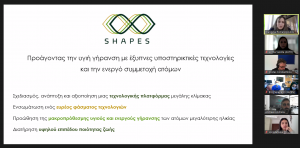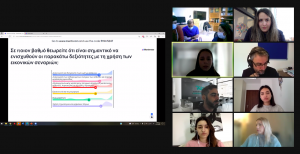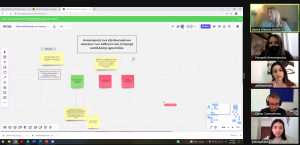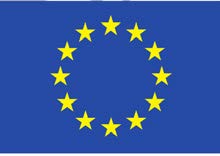Virtual Patient Scenarios (VPS) and Mobile Virtual Patients (MVP) Use Case: Hands-on training session with healthcare professionals
The Aristotle University of Thessaloniki (AUTH) scientific team and partners from the University of Nicosia Research Foundation (UNRF) joined forces and actualized with success the hands-on training of the Use Case ‘‘Virtual Patient Scenarios (VPS) and Mobile Virtual Patients (MVP)’’.The hands-on training was virtually held among two medical students and two SHAPES project partners from the UNRF, three healthcare professionals working in the “Archangelos Michael” Nursing Home (AMEN) and three facilitators from the AUTH team.

Image 1: Hands-on training session with healthcare professionals
The aim of the hands-on training was to engage healthcare professionals in the actual process of developing virtual patient scenarios. Specifically, participants were initially introduced to the SHAPES project aim and objectives (Image 1), followed by a comprehensive presentation of the Virtual Patients Scenarios’ & Mobile Virtual Patients’ platforms. Participants had the opportunity to navigate through the two different platforms and interact with available virtual patient scenarios. Afterwards, the educational needs and knowledge gaps of healthcare professionals were highlighted by participants through an interactive software Mentimeter (Image 2) leading to the main topics of interest for the development of the new scenarios. Participants were then allocated in break-out rooms, in order to engage in a brainstorming session.

Image 2: Selection of topics for scenarios’ development using interactive software (Mentimeter)
During this session, participants were divided into two groups and proceeded with the design and development of two scenarios’ scripts through fruitful discussions and active brainstorming exploiting the online Miro whiteboard (Image 3). This engaging process allowed healthcare professionals to actively interact with virtual scenarios and develop their own with essential content. This was a great opportunity to collaborate and proceed with the first steps of virtual patients’ scenarios development before the actualization of the piloting activities.

Image 3: Final scenarios depicted in the online whiteboard (Miro)


